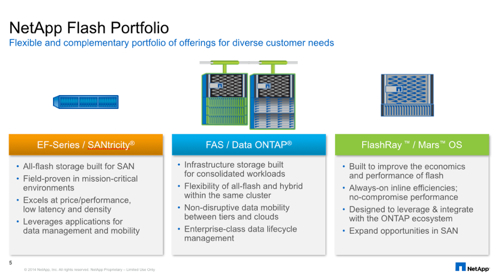This article is more than 1 year old
NetApp's running with the big dogs: All-flash FlashRay hits the street
But it's not yet ready for prime time, strangely
NetApp’s all-new FlashRay solid state array has been launched with limited availability and is not yet ready for prime time, having only a single controller, and lacking scale-out features and some ONTAP integration.
These will come with future product upgrades, allowing NetApp to harden and fine-tune the product with this release.
It is a ground-up designed array with hardware and Mars software developed by NetApp in an internal start-up organisation. The product enables NetApp to start competing on an equal footing with with startups like Kaminario, Pure Storage and SolidFire, semi-established Violin Memory.
FlashRay also pits NetApp against mainstream competitors such as Cisco, with its temporarily suspended Invicta, Dell, Fujitsu, EMC, HP, HDS, and IBM.
FlashRay is positioned as a low-latency, high-performance array and will integrated with the mothership, NetApp’s ONTAP FAS arrays. Flash Solutions VP Ty McConney says customers do not want another storage silo.
For now FlashRay is another silo but is not completely separate from the ONTAP world, not like the EF Series. It will have tighter integration with ONTAP on its roadmap, including seamless data mobility, “enabling enterprises to move data to the right storage tier as part of a comprehensive data lifecycle management strategy.”
The Mars operating system provides always-on, inline deduplication and compression using FlashRay’s Variable Length Block Layout (VLBL) that can cope with variable block lengths and provide what NetApp terms “byte-granular compression.”
NetApp says that if a 32K piece of data needs writing with 8K block lengths, and it is compressed to 25K, and therefore above a 24K block boundary (3 x 8K) then 32K still gets written. Whereas, with byte-granular compression, only 25K of data gets written, saving flash writes and helping to prolong endurance.
FlashRay has, or will have, integrated data protection.
NetApp flash array positioning
There are now three all-flash storage array offerings from NetApp; the Engenio-based EF-Series, the all-flash FAS, and now FlashRay.
FlashRay will provide higher data access performance than FAS and be aimed at database and transaction processing applications where I/O latency needs to be low and integration within the ONTAP environment is desired.
FAS flash provides higher-than disk data access speed completely inside the ONTAP environment and with all ONTAP data management services available.
The EF-Series provides raw flash array grunt, so-to-speak, with faster data access than FAS ONTAP arrays, and is suitable for use cases where the application software provides data management services.
As a single-controller array, for now, FlashRay isn’t suitable for mission-critical applications, not unless you purchase two and have high-layer software to provide the high-availability needed.
Speeds and feeds
- FlashRay will be able to scale-up capacity on a single, dual-node system, and scale-out both performance and capacity with additional nodes in a cluster.
- All the nodes in the scale-out cluster will export a single large “container”. NetApp is not revealing the interconnect at this time.
- The initial release provides 11.5TB raw capacity (10.5 TiB) and 7.86TB usable capacity (7.15TiB).
- Effective capacity will be much higher based on deduplication and compression data reduction rates.
- It uses an X86-based controller.
- NetApp's plan is to integrate FlashRay with ONTAP for data mobility, with, over time, the ability to move data between ONTAP and the Mars OS, integration of manageability tools, and common application integration tools.
- FlashRay data is protected by proprietary flash-optimised dual-parity RAID.
- FlashRay will ship with 16Gbit/s Fibre Channel ports.
- Management uses the FlashRay System Manager (browser-based GUI) as well as command line and REST Web APIs.
- It uses consumer-grade MLC SSDs with 6Gbit/s SAS connectivity.
- It can sustain 250,000 IOPS @ 0.5 ms latency on 8K random I/O, and 8GB/sec on large-block sequential I/O.
- Release 1 of MARS supports VMware's VAAI.
Takeaway view
FlashRay is a vital offering for NetApp, enabling it to compete on a level playing ground - eventually - with all-flash array competition. Pushing it out in single-controller form is a calculated gamble. It establishes NetApp's flash array bonafides but gives competitors short-term reasons to carp.
NetApp is the only mainstream storage array vendor to build its own flash array hardware and software from the ground-up. Its mainstream array competitors have either bought technology (EMC with XtremIO, Cisco with Whiptail) or adapted existing array technology to varying degrees.
This embarkation on an internal product startup course was a key decision by NetApp, an expensive and time-consuming decision compared to buying a startup or modifying its mainstream (FAS) arrays to run flash well; the course taken by Dell, HDS and HP.
NetApp has done that too, developing all-flash FAS, as well as developing the EF-Series before FlashRay, and now has three stakes in the game. It has to succeed in this endeavour.
It's far too too early to say if it will succeed. This is a version one product. FlashRay's full form has yet to be revealed. All we have is a staging post on the way to the full thing. It looks good, so far, but judgement has to be suspended until the dual-controller, high-availability, ONTAP-integrated, all-singing, all-dancing FlashRay box flickers into view.
FlashRay in this initial form is surely enough to convince customers NetApp is committed to delivering a good product. They’ll wait to see how it develops through the early availability to to selected customers and partners. General availability will come, we think, early next year. Then we’ll see how it really matches up to the competition. ®

